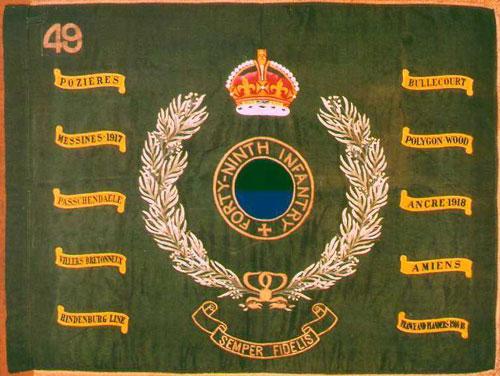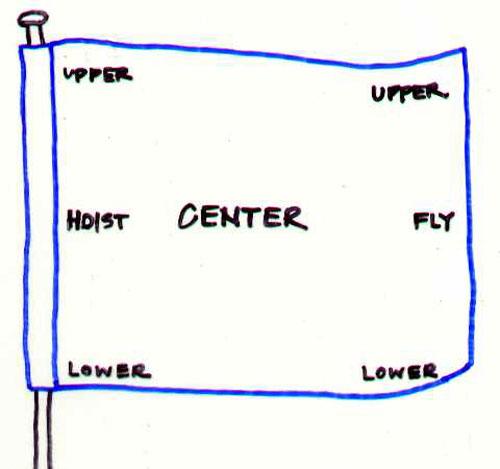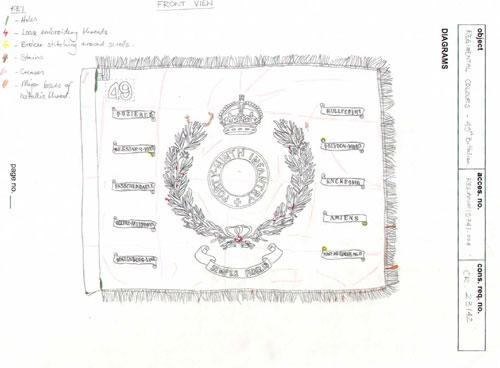Conservation of the 49th Battalion Regimental Colours
Background
Regimental Colours are the focal point of all the loyalty, spirit and traditions that made their regiment great. Emblazoned with Battle Honours, they are expensive and precious items, intricately hand embroidered on silk with metal and silk threads. Before being presented, Colours are always consecrated at a religious ceremony where God's blessing is requested. In earlier days the colours were trooped through the ranks prior to an engagement so that they could be recognised by all ranks as a rallying point during the battle. Today the Trooping of the Colours through the ranks of the Regiment continues as a ceremonial tradition. Customarily, when a Regimental Colour was too old to be used, or no longer required it was hung in a church. Today it is more common for Regimental Colours to be given to a museum for long term care. The Regimental Colour of the 49th Battalion was given to the Australian War Memorial in 1958.

Construction
The regimental colour is made from one layer of green silk, edged with gold. The 49th Infantry colour patch is appliqued onto the center of the colour and is encircled by embroidered gold metal thread. Rich silk embroidery depicting a garland of flowering wattle and the King's crown surround the colour patch. The motto 'SEMPER FIDELIS' (Always Faithful) is embroidered in gold metal thread onto green silk that is appliqued onto the colour beneath the wattle garland. Yellow Battle Honours embroidered with the names of 10 battles are appliqued onto the flag on either side of the central colour patch and embroidery.

Condition
Given its age and original use, the colour was in remarkable condition. The major damage consisted of tears to the top and bottom edges of the colour along the hoist seam. The upper corner had suffered earlier damage and had been repaired with a matching square of green silk attached to the face of the colour with machine zigzag stitching. Some yellow scroll ends had damaged stitching and were lifting from the green ground fabric of the colour. Other minor damage consisted of loose embroidery threads, and the loss of metal coating from some areas of the fringing. Due to the large amount of embroidery and applique work, the ground fabric of the colour was slightly wrinkled from uneven tension and is also creased due to previous folded storage.

Treatment
In all conservation work, objects are fully documented before any treatment can begin. Photographs, diagrams and written reports give detailed information on the materials, construction and condition of the object prior to conservation. Treatment is also fully documented so that conservators in the future have a treatment history that details specific materials and techniques that have been used.
During treatment of the 49th Battalion Regimental colours, the tears along the hoist seam were repaired with specially dyed silk backings. Loose embroidery threads and appliqued pieces were secured with stitching where necessary, and treatment to reduce the creases was carried out.
Mounting for Vertical Display
The regimental colour is displayed vertically on a fabric-covered board in Anzac Hall. To lessen the problem of creasing caused by the tension of the embroidery and metal thread fringe, a pillow was made to sit underneath the colour. The colour was laid over the pillow and secured to the fabric covered board with a row of running stitch. Stitching in the areas of green silk was avoided due to the tight weave and fragile nature of the fabric.
The hoist edge was secured to the backing board by a length of specially dyed crepeline ribbon that was threaded through the hoist channel and stitched to the backing board at the top and bottom edges. The metal thread fringe also needed to be secured to prevent it from drooping along the top edge on vertical display. This was achieved using a common textile conservation technique called 'couching'. A length of silk thread was passed through the looped ends of each fringe. Another length of silk thread was then passed under the backing fabric and over the first thread every 2.5cms to secure it to the backing board and hold the fringe in place.
